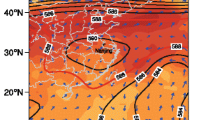Abstract
Rapid urbanization has intensified summer heat waves in recent decades in Beijing, China. In this study, effectiveness of applying high-reflectance roofs on mitigating the warming effects caused by urban expansion and foehn wind was simulated for a record-breaking heat wave occurred in Beijing during July 13–15, 2002. Simulation experiments were performed using the Weather Research and Forecast (WRF version 3.0) model coupled with an urban canopy model. The modeled diurnal air temperatures were compared well with station observations in the city and the wind convergence caused by urban heat island (UHI) effect could be simulated clearly. By increasing urban roof albedo, the simulated UHI effect was reduced due to decreased net radiation, and the simulated wind convergence in the urban area was weakened. Using WRF3.0 model, the warming effects caused by urban expansion and foehn wind were quantified separately, and were compared with the cooling effect due to the increased roof albedo. Results illustrated that the foehn warming effect under the northwesterly wind contributed greatly to this heat wave event in Beijing, while contribution from urban expansion accompanied by anthropogenic heating was secondary, and was mostly evident at night. Increasing roof albedo could reduce air temperature both in the day and at night, and could more than offset the urban expansion effect. The combined warming caused by the urban expansion and the foehn wind could be potentially offset with high-reflectance roofs by 58.8 % or cooled by 1.4 °C in the early afternoon on July 14, 2002, the hottest day during the heat wave.










Similar content being viewed by others
References
Akbari H, Levinson R, Miller W, Berdahl P (2005) Cool colored roofs to save energy and improve air quality. In: Proceedings of the International Conference on Passive and Low Energy Cooling for the Built Environment, Santorini, Greece, AIVC, INIVE, ISES, and UIA 89-100
Akbari H, Menon S, Rosenfeld A (2009) Global cooling: increasing world-wide urban albedos to offset CO2. Clim Chang 94:275–286
Collins DC, Avissar R (1994) An evaluation with the Fourier amplitude sensitivity test (FAST) of which land-surface parameters are of greatest importance in atmospheric modeling. J Climate 7:681–703
Crawford TM, Stensrud DJ, Mora F, Merchant JW, Wetzel PJ (2001) Value of incorporating satellite-derived land cover data in MM5/PLACE for simulating surface temperatures. J Hydrometeorol 2:453–468
Jiang X, Zhang C, Gao H, Miao S (2007) Impacts of urban albedo change on urban heat island in Beijing—a case study. Acta Meteorologica Sinica 65(2):301–307
Kusaka H, Kimura F (2004) Coupling a single-layer urban canopy model with a simple atmospheric model: impact on urban heat island simulation for an idealized case. J Meteorol Soc Jpn 82:67–80
Kusaka H, Kondo H, Kikegawa Y, Kimura F (2001) A simple single-layer urban canopy model for atmospheric models: comparison with multi-layer and slab models. Bound Layer Meteorol 101:329–335
Liu X, Hu F, Li L, Wang Y (2006) Summer urban climate trends and environmental effect in the Beijing area. Chin J Geophys 49(3):689–697
Niyogi D, Holt T, Zhong S, Pyle PC, Basara J (2006) Urban and land surface effects on the 30 July 2003 mesoscale convective system event observed in the Southern Great Plains. JGR 111:D19107. doi:10.1029/2005JD006746
Niyogi D, Pyle P, Lei M, Arya SP, Kishtawal CM, Shepherd M, Chen F, Wolfe B (2011) Urban modification of thunderstorms: an observational storm climatology and model case study for the Indianapolis urban region. J Appl Meteor Climatol 50:1129–1144
Oleson KW, Bonan GB, Feddema J (2010) Effects of white roofs on urban temperature in a global climate model. Geophys Res Lett. doi:10.1029/2009GL042194
Pielke RA (2001) Influence of the spatial distribution of vegetation and soil on the prediction of cumulus convective rainfall. Rev Geophys 39:151–177
Pielke RA Sr, Pitman A, Niyogi D, Mahmood R, McAlpine C, Hossain F, Goldewijk KK, Nair U, Betts R, Fall S, Reichstein M, Kabat P, de Noblet N (2011) Land use/land cover changes and climate: modeling analysis and observational evidence. Wiley Interdisciplinary Reviews: Clim Chang. doi:10.1002/wcc.144
Pielke RA Sr, Marland G, Betts RA, Chase TN, Eastman JL, Niles JO, Niyoqi DD, Running SW (2002) The influence of land-use change and landscape dynamics on the climate system: relevance to climate-change policy beyond the radiative effect of greenhouse gases. Philos Trans R Soc Lond A360:1705–1719
Rosenfeld AH, Romm JJ, Akbari H, Pomerantz M (1998) Cool communities: strategies for heat islands mitigation and smog reduction. Energy Build 28:51–62
Sailor D (1995) Simulated urban climate response to modifications in surface albedo and vegetative cover. J Appl Meteor 34:1694–1704
Synnefa A, Dandou A, Tombrou M (2008) On the use of cool materials as a heat island mitigation strategy. J Appl Meteorol Climatol 47:2846–2856
Takebayashi H, Moriyama M (2007) Surface heat budget on green roof and high reflection roof for mitigation of urban heat island. Build Environ 42:2971–2979
Yucel I (2006) Effect of implementing MODIS land cover and albedo in MM5 at two contrasting U.S. regions. J Hydrometeorol 7:1043–1060
Zheng Z, Wang Y, Liu W (2006) Numerical simulation study for the effects of terrain and landuse to summer heat wave in Beijing. J Trop Meteorol 22(6):672–676
Acknowledgments
The authors thank Dr. Yongming Xu for assisting with conversion of MODIS land cover data to USGS compatible land cover categories. This work is supported by the Chinese Ministry of Science and Technology 973 Program (2010CB428505), the Priority Academic Program Development of Jiangsu Meteorological Bureau (KM201102). Dr. John C. Hudson at Northwestern University helped with the language.
Author information
Authors and Affiliations
Corresponding author
Additional information
Responsible editor: M. Kaplan.
Rights and permissions
About this article
Cite this article
Ma, H., Shao, H. & Song, J. Modeling the relative roles of the foehn wind and urban expansion in the 2002 Beijing heat wave and possible mitigation by high reflective roofs. Meteorol Atmos Phys 123, 105–114 (2014). https://doi.org/10.1007/s00703-013-0289-x
Received:
Accepted:
Published:
Issue Date:
DOI: https://doi.org/10.1007/s00703-013-0289-x




